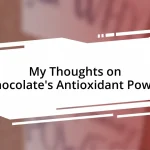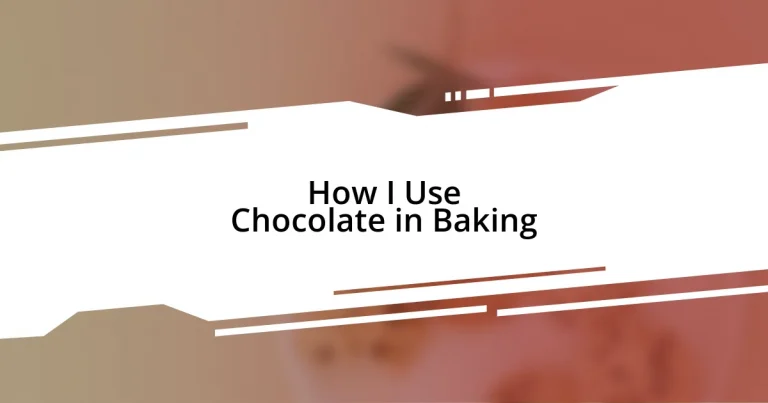Key takeaways:
- Choosing high-quality chocolate with appropriate cocoa content can significantly enhance the flavor of baked goods.
- Different types of chocolate (dark, milk, and white) each bring unique characteristics and can be paired creatively in recipes.
- Proper techniques for melting chocolate, including using a double boiler or microwave with caution, ensure smooth results.
- Correct storage of chocolate is crucial to maintaining its freshness, texture, and flavor; avoid refrigeration to prevent bloom.
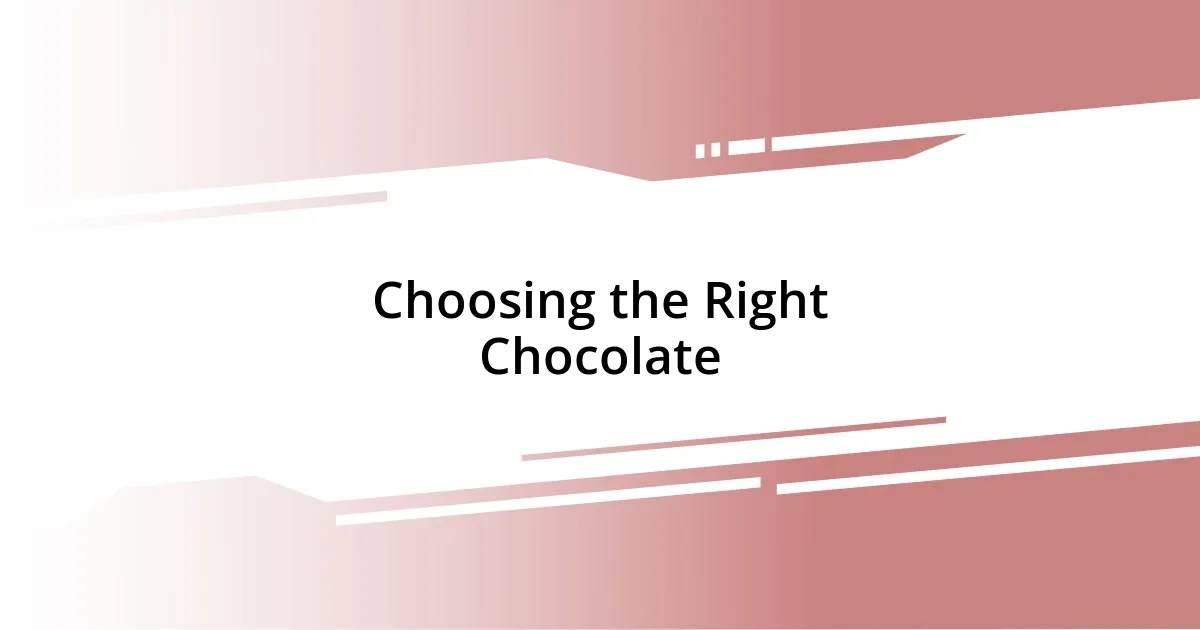
Choosing the Right Chocolate
When it comes to choosing the right chocolate, I always start with the cocoa content. Dark chocolate, for instance, ranges from 50% to 90% cocoa. Have you ever tasted a chocolate cake that was just too sweet? I have, and it left me craving that richer, more complex flavor that higher cocoa content delivers.
I’ve found that not all chocolates are created equal. The quality can vary dramatically between brands, and I’ve learned to trust those artisanal chocolates that use single-origin cocoa. Just thinking about the time I splurged on a fancy bar for my brownies brings a smile to my face—the depth of flavor transformed my recipe into a pure indulgence. Isn’t it amazing how a small decision like chocolate quality can elevate an entire dessert?
Price often reflects quality, but not always. I remember experimenting with a mid-range chocolate and being surprised by its boldness—it was a game-changer! So, next time you’re perusing the store, ask yourself: Would I rather save a few bucks or create a dessert that wows? The right chocolate can take your baking from good to extraordinary, and I wholeheartedly believe it’s worth the investment.
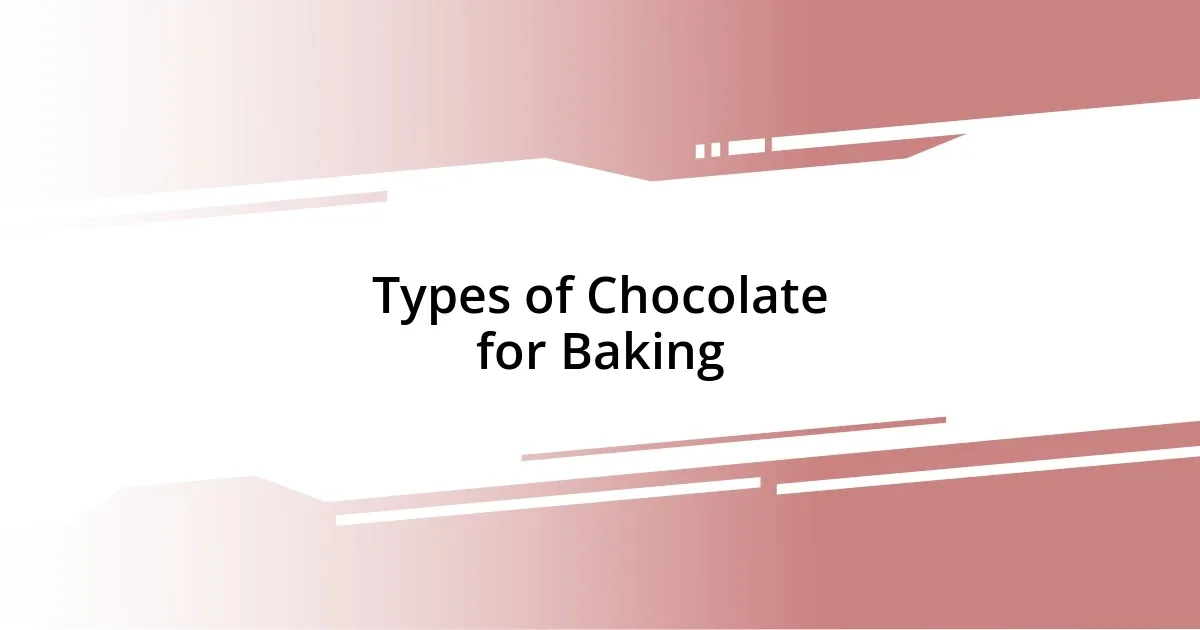
Types of Chocolate for Baking
When baking, I usually rely on three main types of chocolate: dark, milk, and white. Dark chocolate offers an intense cocoa flavor, while milk chocolate adds creaminess and sweetness. I remember a baking session where I used rich dark chocolate for a tart, and the contrast with the buttery crust was absolutely divine—each bite was a taste revelation.
Milk chocolate, with its smoother, sweeter profile, is perfect for cookies and other treats. I once baked a batch of chocolate chip cookies using milk chocolate chips, and they disappeared almost instantly at a family gathering. There’s something heartwarming about sharing a soft, gooey cookie, especially when it brings smiles to everyone’s faces.
White chocolate, though technically not true chocolate since it lacks cocoa solids, still has its place in baking. It offers a unique sweetness and pairs beautifully with fruit or spices. I’ve experimented with white chocolate ganache for cheesecake, and the creamy texture paired with a hint of citrus was nothing short of magical. Each type of chocolate has its personality, and selecting the right one can truly enhance your baking experience.
| Type of Chocolate | Characteristics |
|---|---|
| Dark Chocolate | Intense cocoa flavor, ranges from 50% to 90% cocoa |
| Milk Chocolate | Sweeter, creamier, typically lower cocoa content |
| White Chocolate | Sweet, creamy, lacks cocoa solids, great for pairing |
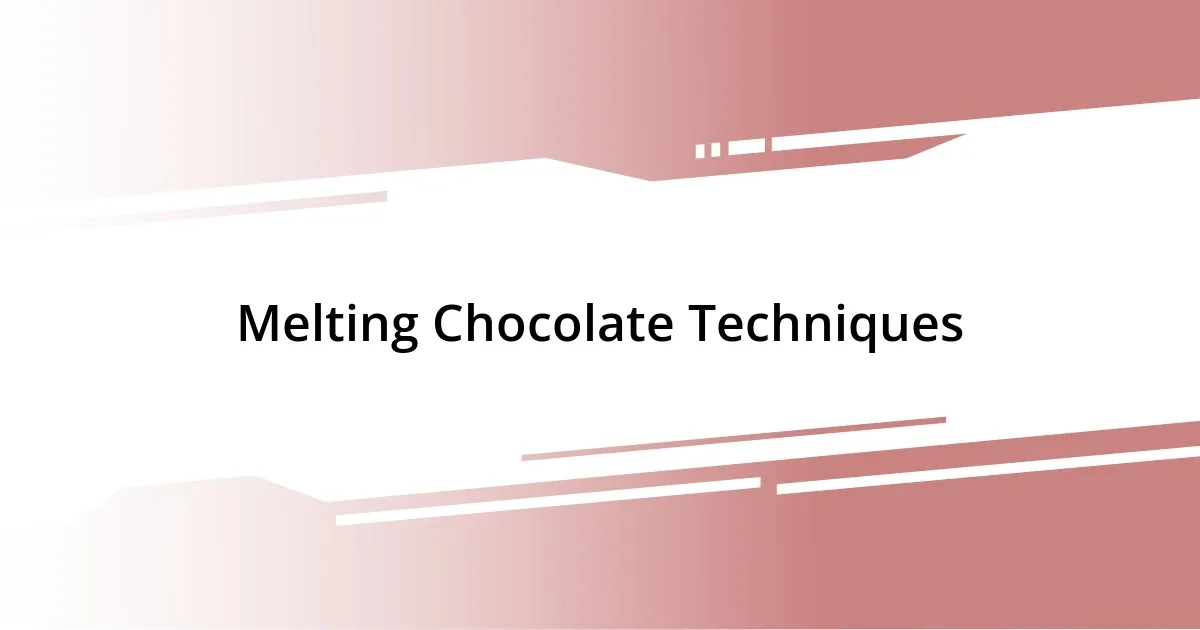
Melting Chocolate Techniques
Melting chocolate can sometimes feel like an art form. I’ve had my fair share of melty disasters—like the time I scorched a beautiful bar of dark chocolate. Now, I swear by a few techniques that ensure smooth, luscious results every time. One favorite method is the double boiler; simply set a heatproof bowl over a pot of simmering water and let the gentle steam work its magic. It’s a slow process, but I enjoy watching the chocolate transform into a glossy pool. I believe it’s worth the wait!
Here are a couple of techniques I find effective for melting chocolate:
- Double Boiler: Ideal for precise control. The steam gently melts the chocolate without direct heat.
- Microwave: Quick and convenient, but requires caution. I set it for 20-second intervals, stirring after each, to prevent overheating.
- Heat Gun: This method is a bit unconventional, but I’ve used it for finer work, especially on tempered chocolate decorations. It melts just the surface beautifully.
Knowing these techniques has made my baking journey so much smoother. I remember feeling frustrated when my chocolate wouldn’t melt properly—it turned the baking process into a chore. Now, with each melting instance, I feel a surge of excitement rather than dread, ready to create something delicious!
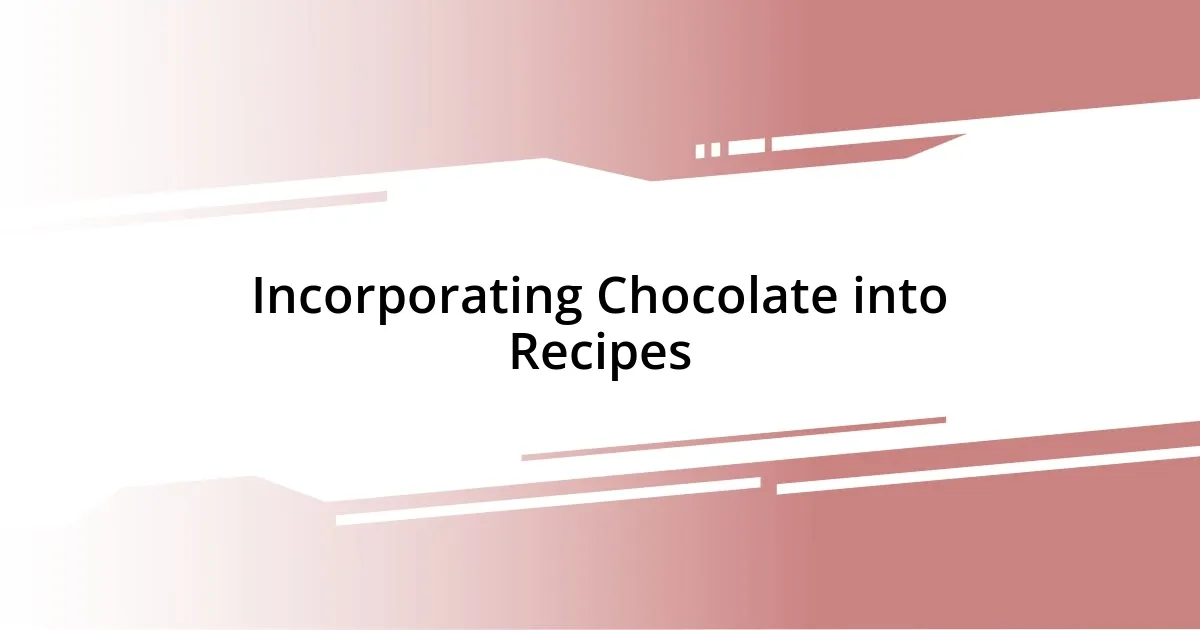
Incorporating Chocolate into Recipes
In my experience, incorporating chocolate into recipes often comes down to timing and technique. For instance, when I make brownies, I mix melted chocolate into the batter. This not only enhances the flavor but also gives the dessert a fudgy, rich texture that’s hard to beat. Have you ever tasted a brownie that was so dense you could barely lift it? That’s the magic of chocolate in action.
I also love playing with different chocolate types to create layered flavors. For example, I once made a chocolate mousse cake that featured both dark chocolate and white chocolate. The contrast between the deep, intense flavor of the dark chocolate and the sweet creaminess of the white was a delightful surprise for my friends. They were captivated by how each layer told a story with chocolate as the main character.
Sometimes, I incorporate chocolate in unexpected ways, like using cocoa powder in pancakes. The result? A breakfast that feels indulgent yet comforting. I remember the first time I served these to my family; the smiles and ‘mmm’ sounds at the table were enough to convince me that chocolate truly has the power to elevate everyday meals. Isn’t it fascinating how a simple ingredient can transform our culinary experiences?
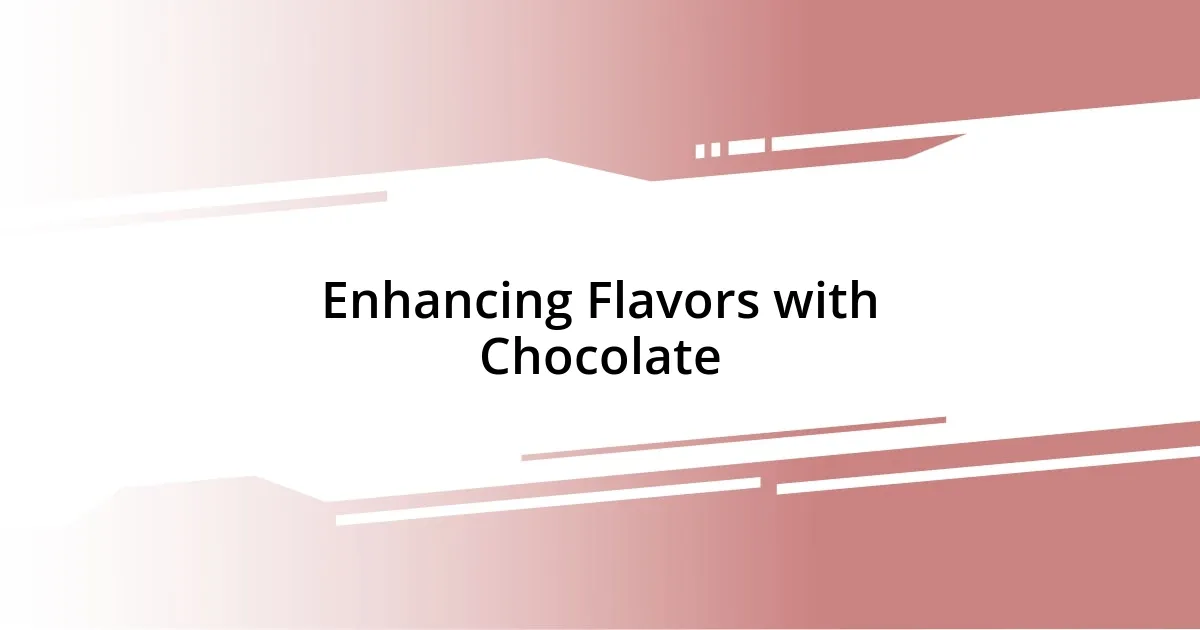
Enhancing Flavors with Chocolate
One of my favorite discoveries in baking is how chocolate can enhance and elevate other flavors. For instance, I once made a chocolate-orange cake that was simply divine. The zesty citrus notes danced beautifully with the rich chocolate, creating a harmony that surprised even my most skeptical friends. Have you ever experienced that moment when two flavors come together so perfectly it feels like they were always meant to be? It’s a magical feeling!
Another flavor pairing I often explore is chocolate and espresso. In my chocolate-chip cookie recipe, I add a touch of espresso powder to amplify the chocolate’s depth. The first time I baked these cookies, I couldn’t believe how the espresso brought out the chocolate’s richness, making each bite feel like an indulgent treat. It’s like having a tiny coffee shop moment in your own kitchen! I find myself rushing to share these cookies, eager to see the looks of delight on my friends’ faces.
Additionally, I love incorporating spices into chocolate recipes for an unexpected twist. Imagine the warm embrace of cinnamon, or the gentle heat of chili powder, mingling with melted chocolate. I remember attempting a Mexican hot chocolate cake that featured both. The subtle spice made my tastebuds sing—it was comforting yet adventurous. Ever had a bite that made you close your eyes and savor every nuance? That’s the power of chocolate, transforming simple ingredients into a symphony of flavors.
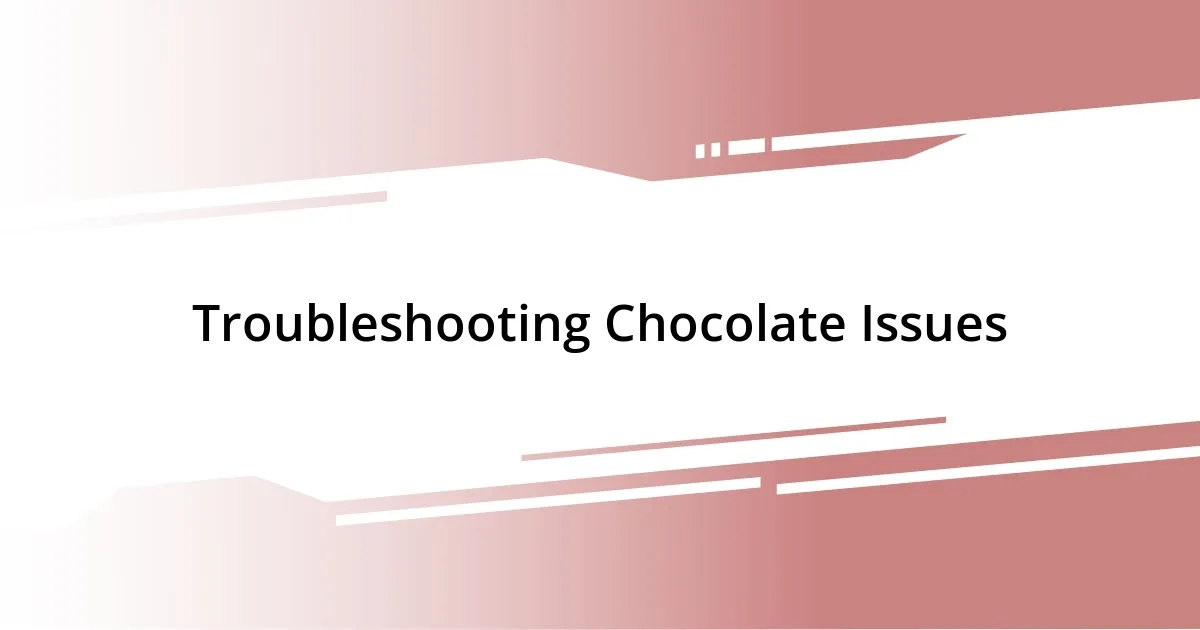
Troubleshooting Chocolate Issues
Sometimes, my biggest chocolate challenges arise when it seizes up or doesn’t melt smoothly. I remember a time when I was trying to make a ganache for a tart, but I accidentally overheated the chocolate. It turned grainy and unappealing. Have you ever faced that moment of panic when your chocolate doesn’t behave? When that happens, I’ve found that adding a tablespoon of warm cream or milk can often help bring it back to life. It’s like giving it a second chance!
Another common issue is the dreaded white film that can appear on chocolate, known as bloom. I once gifted homemade chocolate truffles, and I was mortified to see that white haze on them. It turned out to be caused by temperature fluctuations during storage. Now, I always store my chocolates in a cool, dry place and avoid refrigerating them if possible. Have you realized how crucial proper storage is to maintain chocolate’s pristine appearance?
Texture can also be a concern, especially with chocolate chips melting unevenly in cookies. I’ve learned that if I chill my dough before baking, it helps the chips hold their shape, giving an appealing contrast to the soft, chewy cookie. Isn’t it fascinating how something so simple can change the entire outcome? With lessons learned along the way, troubleshooting these chocolate conundrums has only made my baking journey more rewarding.
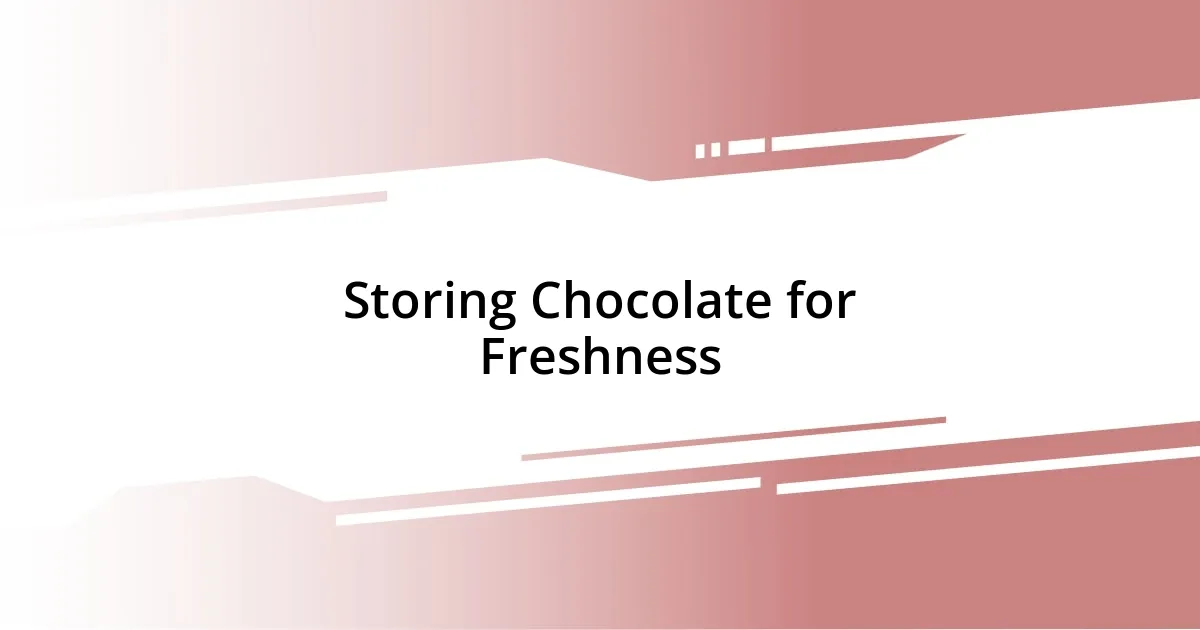
Storing Chocolate for Freshness
Storing chocolate properly can feel like an art in itself. I remember my first time buying a stash of gourmet chocolate bars for a baking project. I was so excited and left them sitting on the counter, thinking they’d be fine. But the next day, I noticed they had lost their glossy sheen and flavor. It was a lesson learned: chocolate prefers a cool, dry environment, ideally between 65°F and 70°F. Have you ever had a favorite treat go stale simply because of poor storage?
I’ve discovered that keeping chocolate in an airtight container can work wonders too. I store mine in a metal or glass container, which helps keep moisture and strong odors at bay. It’s surprising just how much not having a proper sealing can affect chocolate. The last time I didn’t follow this tip, I found my chocolate bars picked up a faint scent from nearby spices. Can you imagine biting into a dark chocolate bar and tasting the remnants of curry powder? Talk about an unexpected surprise!
If you have leftover chocolate after a baking spree, you might be tempted to toss it in the fridge. However, I’ve found that chilling chocolate can sometimes lead to unwanted bloom—a white, powdery texture that ruins its appearance. Instead, I let my leftover chocolate cool and wrap it tightly in plastic wrap before storing it. This has helped me recreate the same delightful experience when I finally return to it. After all, isn’t it lovely to unwrap something you’ve saved and have it taste as good as the day you bought it?










